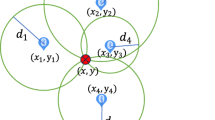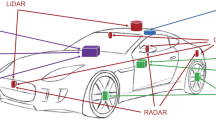Abstract
People spend most of their life time in indoor environments and in all of these environments, Location Service Providers (LSPs) improve users’ navigation. Preserving privacy in Location Based Services (LBSs) is vital for indoor LBSs and fingerprinting based indoor localization method is an emerging technique in indoor localization. In such systems, LSP may be curious and untrusted. Therefore, it is preferred that user estimates its location by using a Partial Radio Map (PRM) which is achieved by LSP, anonymously. In this paper, a privacy preserving method that uses Bloom filter for preserving anonymity and creating PRM during localization process, is proposed. In this method, LSP cannot recognize user identity, which is anonymized by the anonymizer. The proposed method has lower computational complexity compared with methods that use encryption or clustering concepts. The proposed method also has higher accuracy in localization compared with those that use Bloom filter with one random selected AP. Then, in order to decrease the complexity and to increase the accuracy at the same time, we introduce a method that expands the radio map by authenticated users, without compromising their privacy. We also enhance the performance of this method, using Hilbert curve for preserving the ambiguity of users’ location. After verifying the user’s data, LSP sends a certificate to the authenticated users. This certificate can increase the priority of users in LBS requests. Simulation results and measurements show that the proposed method on average improves the localization accuracy up to 16% compared with existing location privacy methods.





Similar content being viewed by others
References
Harroud H, Ahmed M, Karmouch A (2003) Policy-driven personalized multimedia services for mobile users. IEEE Trans Mobile Comput 2(1):16–24
Raquet J, Martin RK (2008) Non-GNSS radio frequency navigation. In: International conference on acoustics speech and signal processing (ICASSP), pp 5308–5311
El Amine CM, Mohamed O, Boualam B (2016) The implementation of indoor localization based on an experimental study of RSSI using a wireless sensor network. Peer-to-Peer Network Appl 9(4):795–808
Alikhani N, Amirinanloo S, Moghtadaiee V, Ghorashi SA (2017) Fast fingerprinting based indoor localization by Wi-Fi signals. In: International conference on computer and knowledge engineering (ICCKE), pp 241–246
Khatab ZE, Hajihoseini A, Ghorashi SA (2017) A fingerprint method for indoor localization using autoencoder based deep extreme learning machine. IEEE Sensors Lett 2(1):1–4
He S, Chan S-HG (2016) Wi-Fi fingerprint-based indoor positioning: recent advances and comparisons. IEEE Commun Surv Tutorials 18(1):466–490
Wang B, Chen Q, Yang LT, Chao H-C (2016) Indoor smartphone localization via fingerprint crowdsourcing: challenges and approaches. IEEE Wireless Commun 23(3):82–89
Amiri WA, Baza M, Banawan K, Mahmoud M, Alasmary W, Akkaya K (2019) Privacy-preserving smart parking system using blockchain and private information retrieval. arXiv:1904.09703
Wang J, Cai Z, Li Y, Yang D, Li J, Gao H (2018) Protecting query privacy with differentially private k-anonymity in location-based services. Personal and Ubiquitous Computing 22(3):453–469
Yang WD, He YH, Sun LM, Lu X, Li X (2016) An optimal query strategy for protecting location privacy in location-based services. Peer-to-Peer Netw Appl 9(4):752–761
Baza M, Lasla N, Mahmoud M, Abdallah M (2019) B-Ride: ride sharing with privacy-preservation, trust and fair payment atop public blockchain. arXiv:1906.09968
Konstantinidis A, Chatzimilioudis G, Zeinalipour-Yazti D, Mpeis P, Pelekis N, Theodoridis Y (2015) Privacy-preserving indoor localization on smartphones. IEEE Trans Knowl Data Eng 27(11):3042–3055
Vergara-Laurens IJ, Jaimes LG, Labrador MA (2017) Privacy-preserving mechanisms for crowdsensing: survey and research challenges. IEEE Internet of Things Journal 4(4):855–869
Huang Z, Du W, Chen B (2005) Deriving private information from randomized data. In: International conference on management of data proceedings of the ACM SIGMOD, pp 37–48
Domingo-Ferrer J (2006) Microaggregation for database and location privacy. In: International workshop on next generation information technologies and systems, pp 106–116
Tian Y, Song B, Huh E-N (2011) A novel threat evaluation method for privacy-aware system in RFID. Int J Ad Hoc Ubiquitous Comput 8(4):230–240
Alikhani N, Moghtadaiee V, Sazdar AM, Ghorashi SA (2018) A privacy preserving method for crowdsourcing in indoor fingerprinting localization. In: International conference on computer and knowledge engineering (ICCKE), pp 58–62
Peng T, Liu Q, Wang G (2017) Enhanced location privacy preserving scheme in location-based services. IEEE Sys J 11(1):219–230
Luo Z-Y, Shi R-H, Xu M, Zhang S (2018) A novel quantum solution to privacy-preserving nearest neighbor query in location-based services. Int J Theoretical Phys 57(4):1049–1059
Khoshgozaran A, Shahabi C (2007) Blind evaluation of nearest neighbor queries using space transformation to preserve location privacy. In: International symposium on spatial and temporal databases, pp 239–257
Vergara-Laurens IJ, Mendez D, Jaimes LG, Labrador M (2016) A-PIE: an algorithm for preserving privacy, quality of information, and energy consumption in Participatory Sensing Systems. Pervasive and Mobile Computing 32:93–112
Gupta R, Rao UP (2017) An exploration to location based service and its privacy preserving techniques: a survey. Wireless Personal Communications 96(2):1973–2007
Gupta R, Rao UP (2017) Achieving location privacy through CAST in location based services. J Commun Netw 19(3):239– 249
Zeng M, Zhang K, Chen J, Qian H (2018) P3GQ: a practical privacy-preserving generic location-based services query scheme. Pervasive and Mobile Computing 51:56–72
Qin Z, Zhang X, Feng K, Zhang Q, Huang J (2014) An efficient identity-based key management scheme for wireless sensor networks using the bloom filter. Sensors 14(10):17937–17951
Alhi A, Batra S (2016) Privacy-preserving authentication framework using bloom filter for secure vehicular communications. Int J Inform Secur (IJISP) 15(4):433–453
Wang X, Pande A, Zhu J, Mohapatra P (2016) STAMP: enabling privacy-preserving location proofs for mobile users. IEEE/ACM Trans Netw 24(6):3276–3289
Zheng Y, Li M, Lou W, Hou YT (2017) Location based handshake and private proximity test with location tags. IEEE Trans Dependable Secure Comput 14(4):406–419
Li H, Sun L, Zhu H, Lu X, Cheng X (2014) Achieving privacy preservation in WiFi fingerprint-based localization. In: IEEE conference on computer communications (INFOCOM), pp 2337–2345
Wang Y, Huang M, Jin Q, Ma J (2018) DP3: a differential privacy-based privacy-preserving indoor localization mechanism. IEEE Commun Lett 22(12):2547–2550
Bloom BH (1970) Space/time trade-offs in hash coding with allowable errors. Commun ACM 13 (7):422–426
He S, Ji B, Chan S-HG (2016) Chameleon: survey-free updating of a fingerprint database for indoor localization. IEEE Pervasive Computing 15(4):66–75
Bose A, Foh CH (2007) A practical path loss model for indoor Wi-Fi positioning enhancement. In: 6th international conference on information, communications & signal processing. IEEE, pp 1–5
Cormen TH, Leiserson CE, Rivest RL, Stein C (2009) Introduction to algorithms. MIT Press, Cambridge
Ahmadi H, Pham N, Ganti R, Abdelzaher T, Nath S, Han J (2010) Privacy-aware regression modeling of participatory sensing data. In: Proceedings of the 8th ACM conference on embedded networked sensor systems, pp 99–112
Author information
Authors and Affiliations
Corresponding author
Ethics declarations
Conflict of interest
A. M. Sazdar, N. Alikhani, S. A. Ghorashi and A. Khonsari state that there are no conflicts of interest.
Additional information
Ethical approval
This article does not contain any studies with human participants or animals performed by any of the authors.
Publisher’s note
Springer Nature remains neutral with regard to jurisdictional claims in published maps and institutional affiliations.
Rights and permissions
About this article
Cite this article
Sazdar, A.M., Alikhani, N., Ghorashi, S.A. et al. Privacy preserving in indoor fingerprint localization and radio map expansion. Peer-to-Peer Netw. Appl. 14, 121–134 (2021). https://doi.org/10.1007/s12083-020-00950-1
Received:
Accepted:
Published:
Issue Date:
DOI: https://doi.org/10.1007/s12083-020-00950-1




